The Darnley Road/Moray Place footbridge at Regents Park Square was built by the Paisley engineering firm of Hanna, Donald and Wilson in 1877.
The footbridge is an elliptically arched, cast-iron girder bridge with lattice railings which originally had steps down to the platforms of Strathbungo Station, which opened the same year.
Curiously, for the first 85 or so years of its life it never actually reached the other side!
Originally it only provided access from Strathbungo to the platforms of the station; there was no Darnley Road when the station opened, just green fields. Even the OS Map of 1951-52 shows no extension to Darnley Road at that time, and so it seems likely the extension to the other side was only built when the station closed in 1962, perhaps using materials from the dismantled steps to the platforms.
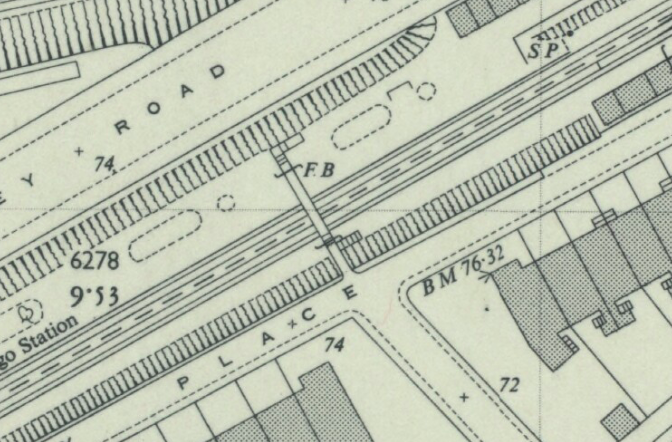
OS Map 1951-2, showing footbridge
The bridge was C listed in 1995 , shortly after the other footbridge was removed, and apparently after one Moray Place resident asked that it be taken down for security reasons and other residents took a different view! None the less its ownership has been recently disputed as no one wanted to be responsible for its likely future maintenance costs. In 2015 Network Rail accepted that it was responsible for the bridge, and agreed to refurbish it. Restoration commenced in October 2018, and was completed in February 2019 .
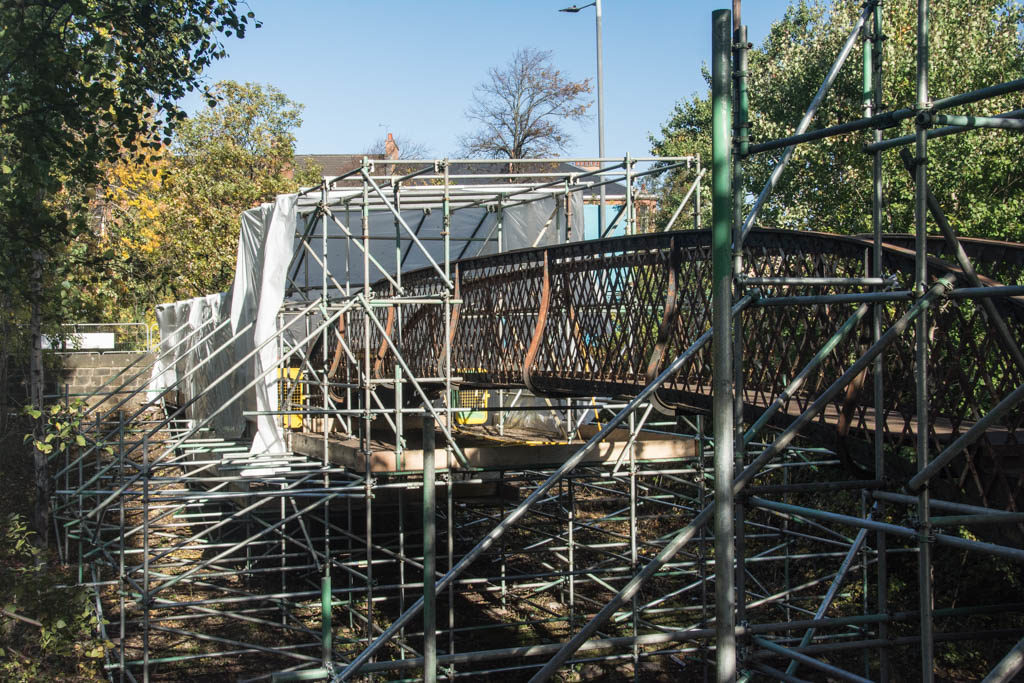
Footbridge restoration October 2018
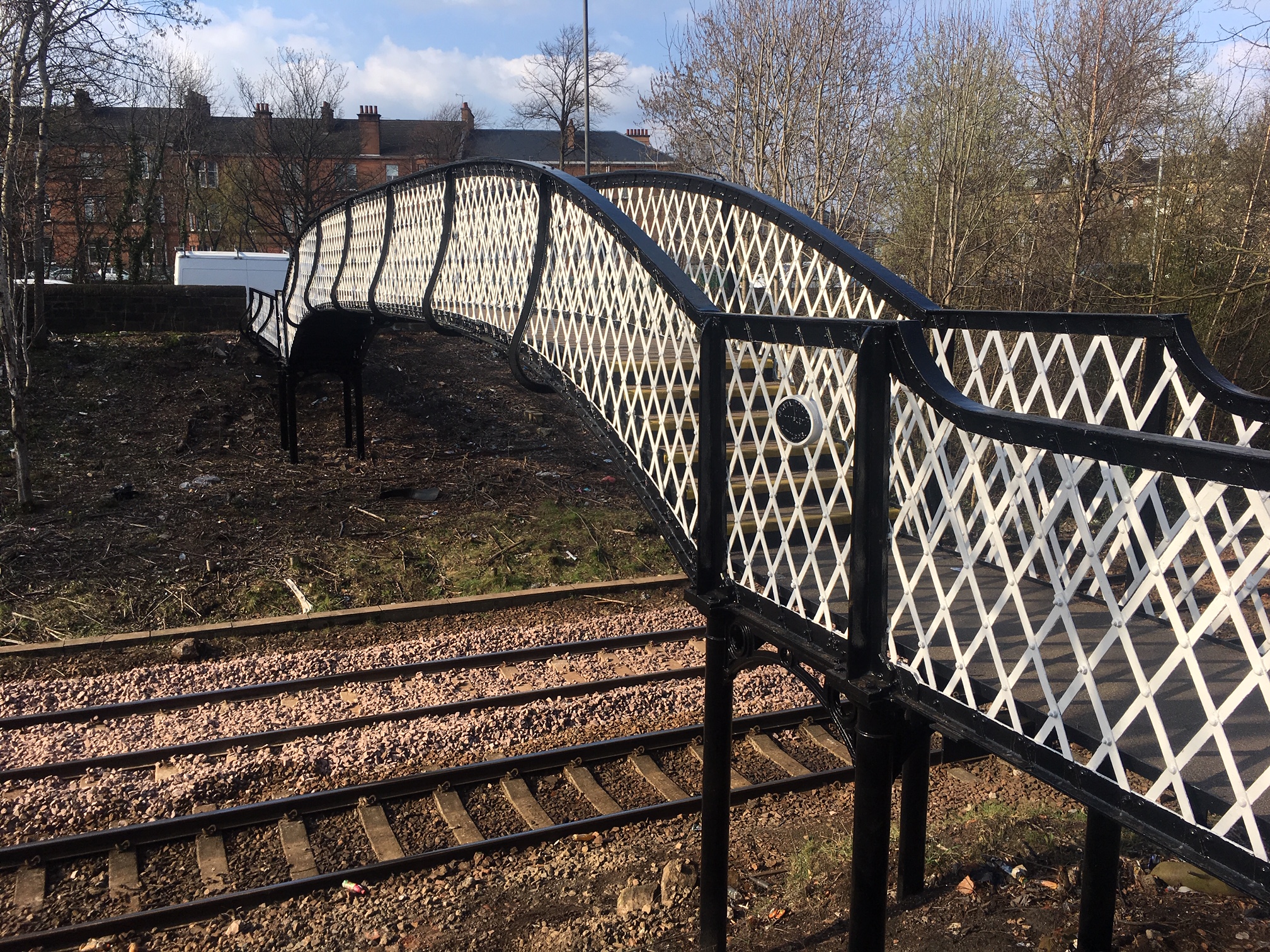
After restoration, April 2019

Maker’s Badge
Removal
Despite restoration, the bridge fell foul of the electrification of the Barhead railway as it was too low, and the latticework too porous to people with sticks, and the risk of electrocution. Despite a long campaign and various counter proposals, the decision was made to remove and replace the bridge.
At 2am on 9 January 2023, the bridge deck was cut free, and lifted onto a trailer to be taken away. The bridge access and supports were also removed. The components have been preserved while Network Rail search for an alternative use, but its future is uncertain.
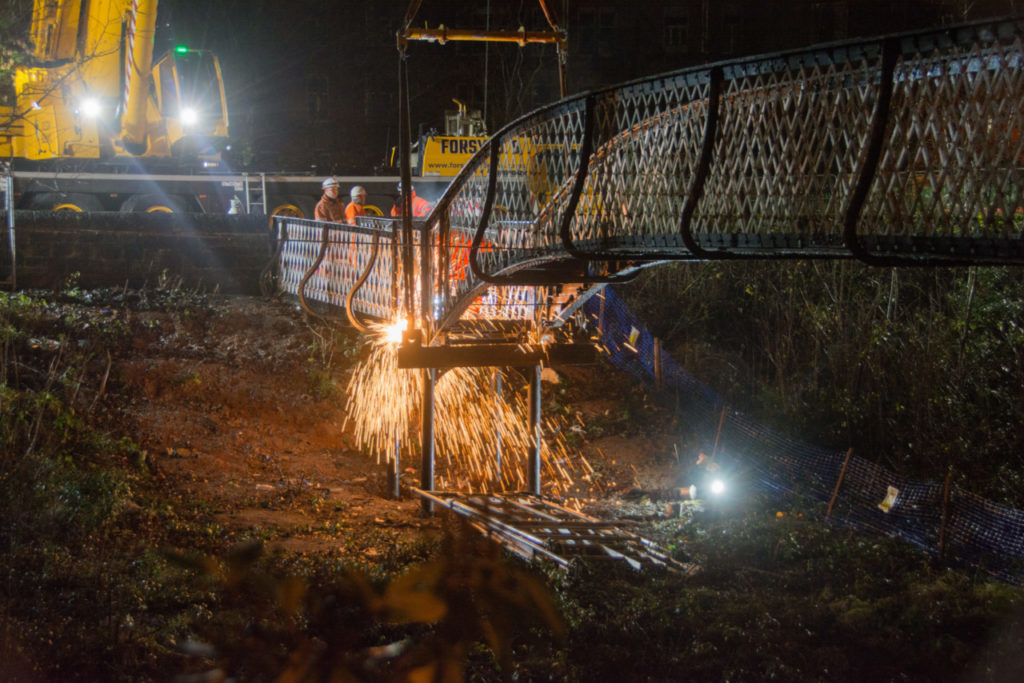
Workers cut away the bridge span prior to lifting.
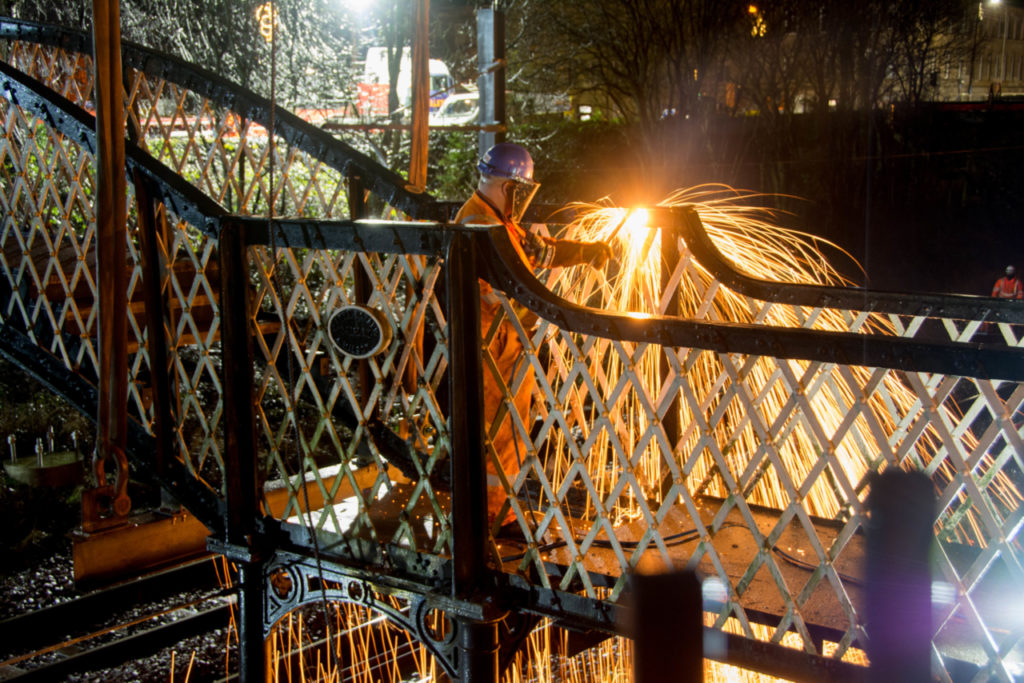
The final cut
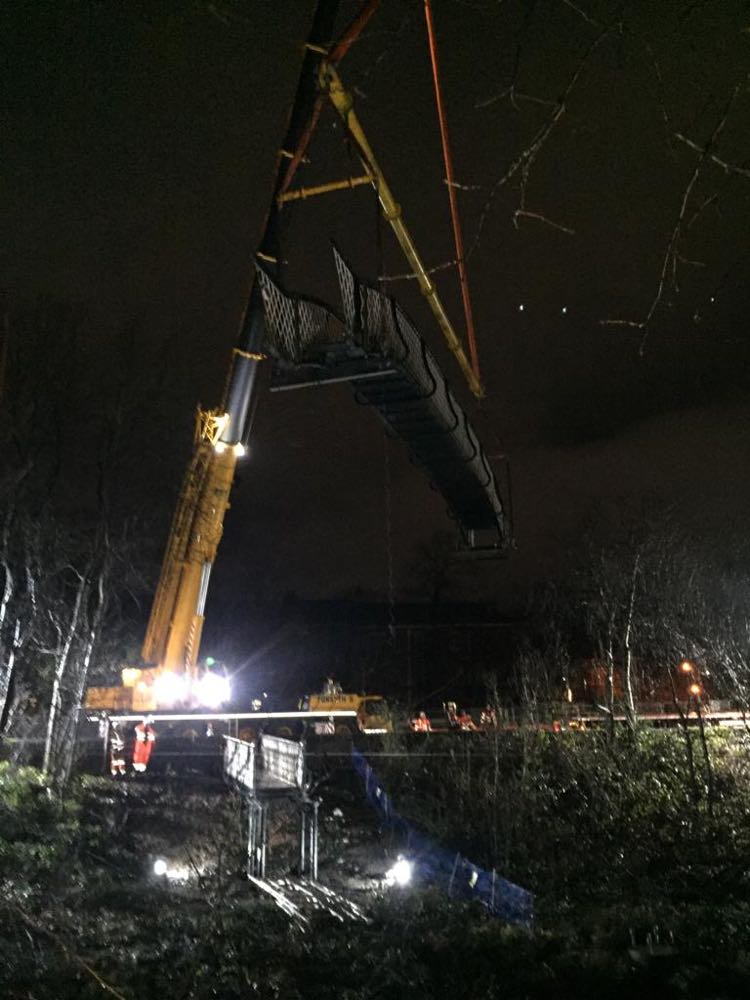
The span is lifted away from the tracks. Credit: Roberto Caviertes
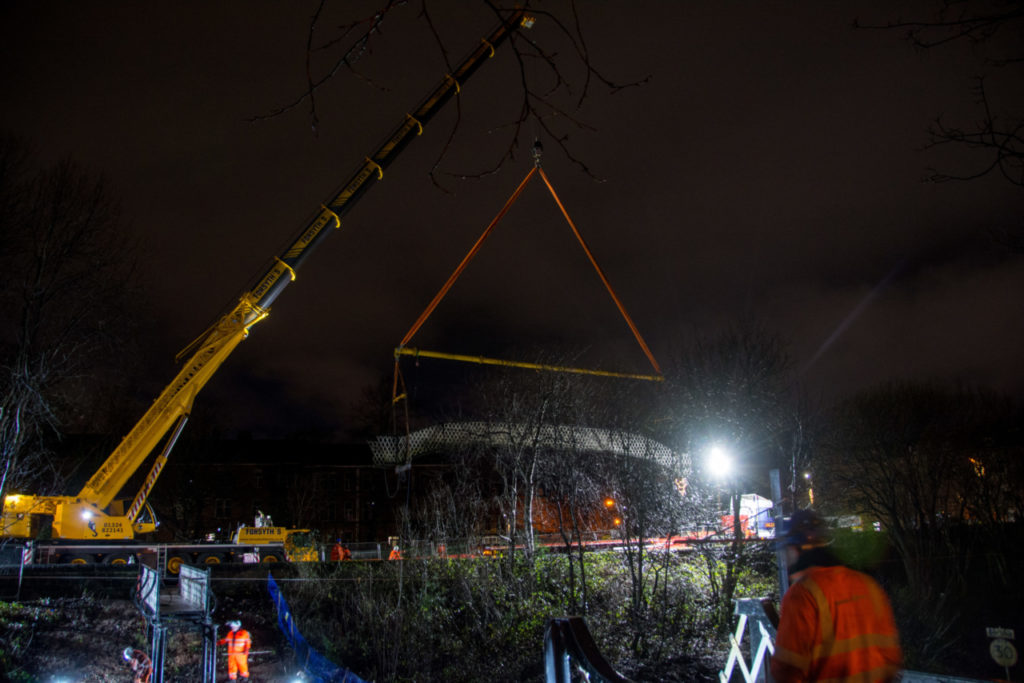
The deck is lowered to a waiting trailer to be taken away to an uncertain fate.
These videos are courtesy of Roberto Caviertes. The second shows the subtle technique for extraction of the support posts.
The bridge is due to be replaced later in 2023, to the following design.

Proposal for the replacement bridge. Credit: Network Rail
Meanwhile the old bridge has been offered to the Caledonian Railway, a volunteer railway preservation charity that runs trains from Brechin to Bridge of Dun in Angus. The bridge will be installed at Brechin Station, and will complement the former Dunblane Station footbridge, of a similar but more elaborate design, that was moved to Bridge of Dun in 2014. The cast iron columns that supported the old Strathbungo Station booking hall will also be incorporated into the Brechin station redevelopment.
Hanna, Donald & Wilson
The manufacturer worked from the Abbey Engineering Works, and the Abercorn Foundry and shipyard, adjacent to the White Cart between North Croft and Niddry Streets, but was wound up in the 1910s . The Abercorn works is now the site of the Wallneuk North Church (1915), while in the 1920s Glasgow Corporation Transport built a transformer on the site of the shipyard to provide power for the tram network. The transformer building survives as the Housing Department.
Hanna, Donald & Wilson built ships, including a couple of underpowered and unsuccessful naval torpedo boats, HMS Fervent & Zephyr . The ships were launched sideways into the White Cart. They also constructed gas holders, boilers, and a variety of other engineering products.
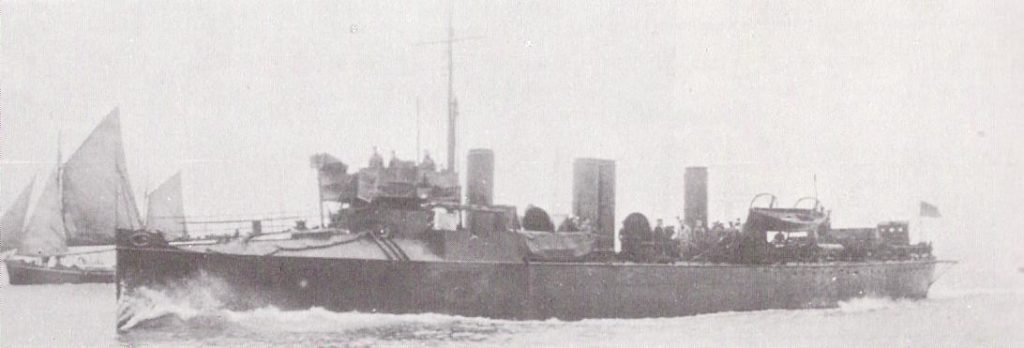
HMS Zephyr
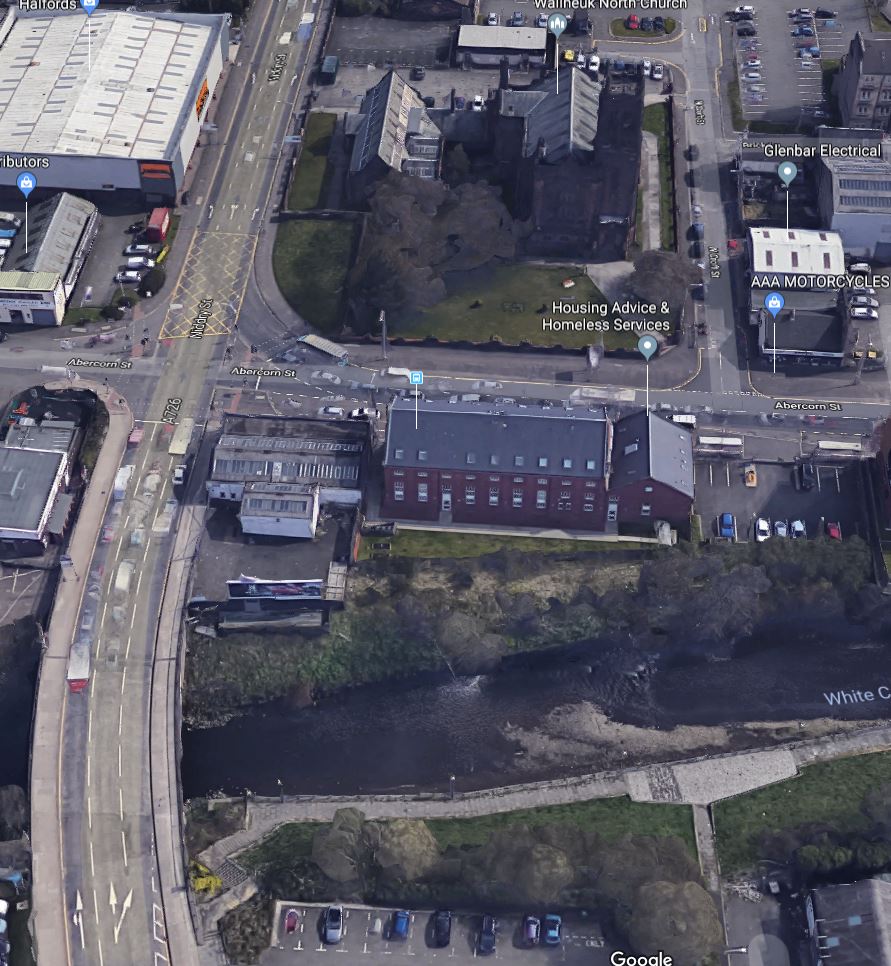
Abercorn Foundry Site, now Wallneuk North Church, and the site of the shipyard, now Housing Offices, with the slipway to the White Cart behind (Google Maps)
Their work on bridges included the Albert Bridge beside Glasgow Green, recently restored, and revisions to the Great Portland Street Suspension Bridge in 1871. They were evidently proud of their bridges, using several in one of their advertisements. And pride of place top left is Strathbungo’s very own footbridge!
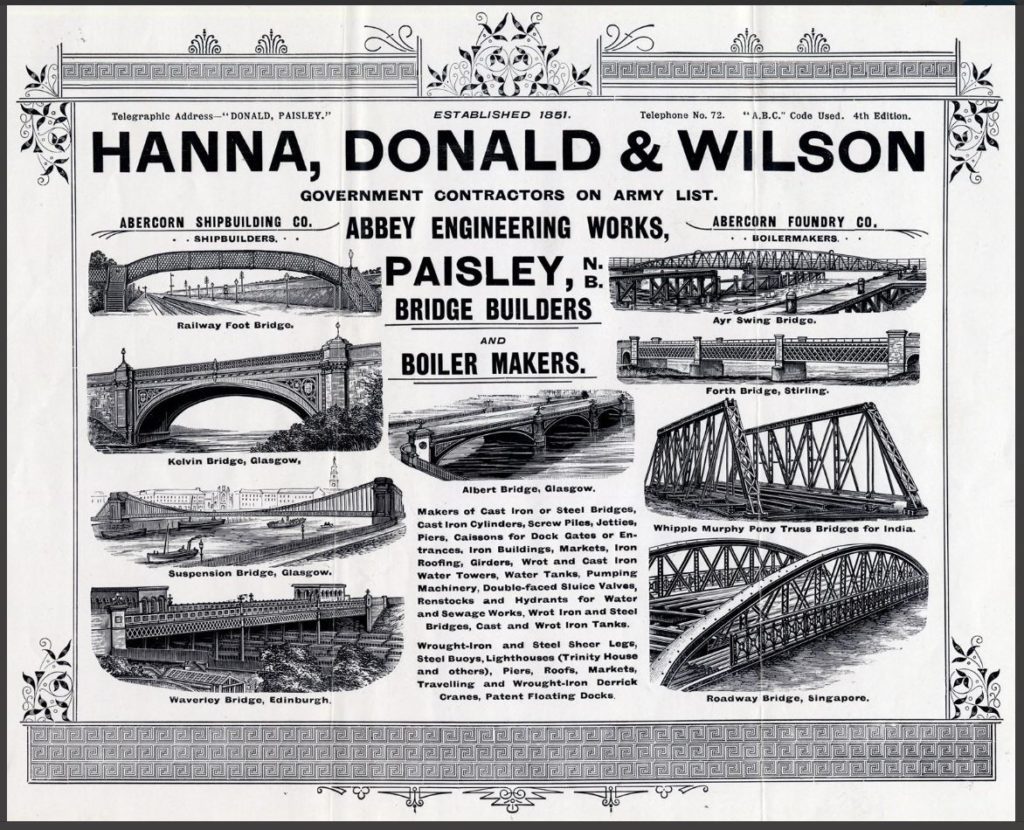
Hanna, Donald & Wilson advert (University of Glasgow Archives) – click to enlarge

Strathbungo Footbridge (enlargement)

Strathbungo Station a year after closure. The Strathbungo footbridge is visible in the distance. Clan 72006 “Clan Mackenzie” heads parcels train on 13th June 1963.
Now, where do you think the photographer was standing? That’s for another posting. Photo courtesy John Robin .
(Article updated 13 Jan 2023)
References
{3557955:7Q6VT8W2};{3557955:TV95R5AD},{3557955:Q4FM7TKT};{3557955:AG9T627K};{3557955:QAQEXJVD};{3557955:FQ3A2FWN}
vancouver
asc
0
81
%7B%22status%22%3A%22success%22%2C%22updateneeded%22%3Afalse%2C%22instance%22%3A%22zotpress-a66697a37d86e14b31ec341ab1db63a8%22%2C%22meta%22%3A%7B%22request_last%22%3A0%2C%22request_next%22%3A0%2C%22used_cache%22%3Atrue%7D%2C%22data%22%3A%5B%7B%22key%22%3A%22Q4FM7TKT%22%2C%22library%22%3A%7B%22id%22%3A3557955%7D%2C%22meta%22%3A%7B%22numChildren%22%3A1%7D%2C%22bib%22%3A%22%3Cdiv%20class%3D%5C%22csl-bib-body%5C%22%20style%3D%5C%22line-height%3A%201.35%3B%20%5C%22%3E%5Cn%20%20%3Cdiv%20class%3D%5C%22csl-entry%5C%22%20style%3D%5C%22clear%3A%20left%3B%20%5C%22%3E%5Cn%20%20%20%20%3Cdiv%20class%3D%5C%22csl-left-margin%5C%22%20style%3D%5C%22float%3A%20left%3B%20padding-right%3A%200.5em%3B%20text-align%3A%20right%3B%20width%3A%201em%3B%5C%22%3E1.%3C%5C%2Fdiv%3E%3Cdiv%20class%3D%5C%22csl-right-inline%5C%22%20style%3D%5C%22margin%3A%200%20.4em%200%201.5em%3B%5C%22%3ENetwork%20Rail%20Media%20Centre%20%5BInternet%5D.%20%5Bcited%202020%20Apr%2013%5D.%20Bridge%20refurbishment%20re-connects%20Glasgow%20conservation%20areas.%20Available%20from%3A%20%3Ca%20href%3D%27https%3A%5C%2F%5C%2Fwww.networkrailmediacentre.co.uk%5C%2Fnews%5C%2Fbridge-refurbishment-re-connects-conservation-areas%27%3Ehttps%3A%5C%2F%5C%2Fwww.networkrailmediacentre.co.uk%5C%2Fnews%5C%2Fbridge-refurbishment-re-connects-conservation-areas%3C%5C%2Fa%3E%3C%5C%2Fdiv%3E%5Cn%20%20%3C%5C%2Fdiv%3E%5Cn%3C%5C%2Fdiv%3E%22%2C%22data%22%3A%7B%22itemType%22%3A%22webpage%22%2C%22title%22%3A%22Bridge%20refurbishment%20re-connects%20Glasgow%20conservation%20areas%22%2C%22creators%22%3A%5B%5D%2C%22abstractNote%22%3A%22Network%20Rail%20has%20completed%20the%20refurbishment%20of%20the%20former%20Strathbungo%20station%20footbridge%20connecting%20Moray%20Place%20and%20Darnley%20Road%20on%20Glasgow%5Cu2019s%20southside.%22%2C%22date%22%3A%22%22%2C%22url%22%3A%22https%3A%5C%2F%5C%2Fwww.networkrailmediacentre.co.uk%5C%2Fnews%5C%2Fbridge-refurbishment-re-connects-conservation-areas%22%2C%22language%22%3A%22english%22%2C%22collections%22%3A%5B%22CAR6MXPM%22%5D%2C%22dateModified%22%3A%222020-04-13T13%3A59%3A01Z%22%7D%7D%2C%7B%22key%22%3A%22TV95R5AD%22%2C%22library%22%3A%7B%22id%22%3A3557955%7D%2C%22meta%22%3A%7B%22numChildren%22%3A1%7D%2C%22bib%22%3A%22%3Cdiv%20class%3D%5C%22csl-bib-body%5C%22%20style%3D%5C%22line-height%3A%201.35%3B%20%5C%22%3E%5Cn%20%20%3Cdiv%20class%3D%5C%22csl-entry%5C%22%20style%3D%5C%22clear%3A%20left%3B%20%5C%22%3E%5Cn%20%20%20%20%3Cdiv%20class%3D%5C%22csl-left-margin%5C%22%20style%3D%5C%22float%3A%20left%3B%20padding-right%3A%200.5em%3B%20text-align%3A%20right%3B%20width%3A%201em%3B%5C%22%3E1.%3C%5C%2Fdiv%3E%3Cdiv%20class%3D%5C%22csl-right-inline%5C%22%20style%3D%5C%22margin%3A%200%20.4em%200%201.5em%3B%5C%22%3EMHB%20Consultants%20%5BInternet%5D.%20%5Bcited%202020%20Apr%2013%5D.%20Strathbungo%20Footbridge.%20Available%20from%3A%20%3Ca%20href%3D%27https%3A%5C%2F%5C%2Fwww.mhbconsultants.com%5C%2Fprojects%5C%2Fcurrent-projects%5C%2Fbridge-engineering%5C%2Fstrathbungo-footbridge%5C%2F%27%3Ehttps%3A%5C%2F%5C%2Fwww.mhbconsultants.com%5C%2Fprojects%5C%2Fcurrent-projects%5C%2Fbridge-engineering%5C%2Fstrathbungo-footbridge%5C%2F%3C%5C%2Fa%3E%3C%5C%2Fdiv%3E%5Cn%20%20%3C%5C%2Fdiv%3E%5Cn%3C%5C%2Fdiv%3E%22%2C%22data%22%3A%7B%22itemType%22%3A%22webpage%22%2C%22title%22%3A%22Strathbungo%20Footbridge%22%2C%22creators%22%3A%5B%5D%2C%22abstractNote%22%3A%22MHB%20Consultants%20were%20contracted%20by%20Taziker%20Industrial%2C%20on%20behalf%20of%20Network%20Rail%2C%20to%20undertake%20the%20detailed%20design%20of%20the%20refurbishment%20of%20Strathbungo%20Footbridge.%2C%20MHB%20Consultants%20were%20contracted%20by%20Taziker%20Industrial%2C%20on%20behalf%20of%20Network%20Rail%2C%20to%20undertake%20the%20detailed%20design%20of%20the%20refurbishment%20of%20Strathbungo%20Footbridge.%22%2C%22date%22%3A%22%22%2C%22url%22%3A%22https%3A%5C%2F%5C%2Fwww.mhbconsultants.com%5C%2Fprojects%5C%2Fcurrent-projects%5C%2Fbridge-engineering%5C%2Fstrathbungo-footbridge%5C%2F%22%2C%22language%22%3A%22en%22%2C%22collections%22%3A%5B%22CAR6MXPM%22%5D%2C%22dateModified%22%3A%222020-04-13T13%3A58%3A58Z%22%7D%7D%2C%7B%22key%22%3A%22AG9T627K%22%2C%22library%22%3A%7B%22id%22%3A3557955%7D%2C%22meta%22%3A%7B%22numChildren%22%3A1%7D%2C%22bib%22%3A%22%3Cdiv%20class%3D%5C%22csl-bib-body%5C%22%20style%3D%5C%22line-height%3A%201.35%3B%20%5C%22%3E%5Cn%20%20%3Cdiv%20class%3D%5C%22csl-entry%5C%22%20style%3D%5C%22clear%3A%20left%3B%20%5C%22%3E%5Cn%20%20%20%20%3Cdiv%20class%3D%5C%22csl-left-margin%5C%22%20style%3D%5C%22float%3A%20left%3B%20padding-right%3A%200.5em%3B%20text-align%3A%20right%3B%20width%3A%201em%3B%5C%22%3E1.%3C%5C%2Fdiv%3E%3Cdiv%20class%3D%5C%22csl-right-inline%5C%22%20style%3D%5C%22margin%3A%200%20.4em%200%201.5em%3B%5C%22%3ERecords%20of%20Hanna%2C%20Donald%20%26amp%3B%20Wilson%2C%20shipbuilders%20and%20engineers%2C%20Paisley%2C%20Renfrewshire%2C%20Scotland%20-%20Archives%20Hub%20%5BInternet%5D.%20%5Bcited%202019%20Jan%2012%5D.%20Available%20from%3A%20%3Ca%20href%3D%27https%3A%5C%2F%5C%2Farchiveshub.jisc.ac.uk%5C%2Fdata%5C%2Fgb248-ugd284%27%3Ehttps%3A%5C%2F%5C%2Farchiveshub.jisc.ac.uk%5C%2Fdata%5C%2Fgb248-ugd284%3C%5C%2Fa%3E%3C%5C%2Fdiv%3E%5Cn%20%20%3C%5C%2Fdiv%3E%5Cn%3C%5C%2Fdiv%3E%22%2C%22data%22%3A%7B%22itemType%22%3A%22webpage%22%2C%22title%22%3A%22Records%20of%20Hanna%2C%20Donald%20%26%20Wilson%2C%20shipbuilders%20and%20engineers%2C%20Paisley%2C%20Renfrewshire%2C%20Scotland%20-%20Archives%20Hub%22%2C%22creators%22%3A%5B%5D%2C%22abstractNote%22%3A%22%22%2C%22date%22%3A%22%22%2C%22url%22%3A%22https%3A%5C%2F%5C%2Farchiveshub.jisc.ac.uk%5C%2Fdata%5C%2Fgb248-ugd284%22%2C%22language%22%3A%22%22%2C%22collections%22%3A%5B%22CAR6MXPM%22%5D%2C%22dateModified%22%3A%222019-01-12T16%3A30%3A17Z%22%7D%7D%2C%7B%22key%22%3A%22QAQEXJVD%22%2C%22library%22%3A%7B%22id%22%3A3557955%7D%2C%22meta%22%3A%7B%22parsedDate%22%3A%222018-11-11%22%2C%22numChildren%22%3A1%7D%2C%22bib%22%3A%22%3Cdiv%20class%3D%5C%22csl-bib-body%5C%22%20style%3D%5C%22line-height%3A%201.35%3B%20%5C%22%3E%5Cn%20%20%3Cdiv%20class%3D%5C%22csl-entry%5C%22%20style%3D%5C%22clear%3A%20left%3B%20%5C%22%3E%5Cn%20%20%20%20%3Cdiv%20class%3D%5C%22csl-left-margin%5C%22%20style%3D%5C%22float%3A%20left%3B%20padding-right%3A%200.5em%3B%20text-align%3A%20right%3B%20width%3A%201em%3B%5C%22%3E1.%3C%5C%2Fdiv%3E%3Cdiv%20class%3D%5C%22csl-right-inline%5C%22%20style%3D%5C%22margin%3A%200%20.4em%200%201.5em%3B%5C%22%3EHMS%20Zephyr%20%281895%29.%20In%3A%20Wikipedia%20%5BInternet%5D.%202018%20%5Bcited%202019%20Jan%2012%5D.%20Available%20from%3A%20%3Ca%20href%3D%27https%3A%5C%2F%5C%2Fen.wikipedia.org%5C%2Fw%5C%2Findex.php%3Ftitle%3DHMS_Zephyr_%281895%29%26oldid%3D868363523%27%3Ehttps%3A%5C%2F%5C%2Fen.wikipedia.org%5C%2Fw%5C%2Findex.php%3Ftitle%3DHMS_Zephyr_%281895%29%26oldid%3D868363523%3C%5C%2Fa%3E%3C%5C%2Fdiv%3E%5Cn%20%20%3C%5C%2Fdiv%3E%5Cn%3C%5C%2Fdiv%3E%22%2C%22data%22%3A%7B%22itemType%22%3A%22encyclopediaArticle%22%2C%22title%22%3A%22HMS%20Zephyr%20%281895%29%22%2C%22creators%22%3A%5B%5D%2C%22abstractNote%22%3A%22HMS%20Zephyr%20was%20one%20of%20two%20Fervent-class%20destroyers%20which%20served%20with%20the%20Royal%20Navy.%20She%20was%20launched%20on%2010%20May%201895%20from%20Hanna%2C%20Donald%20%26%20Wilson%20at%20Paisley%2C%20Scotland.%20She%20served%20in%20home%20waters%2C%20and%20was%20sold%20in%201920.%22%2C%22encyclopediaTitle%22%3A%22Wikipedia%22%2C%22date%22%3A%222018-11-11T18%3A45%3A10Z%22%2C%22ISBN%22%3A%22%22%2C%22url%22%3A%22https%3A%5C%2F%5C%2Fen.wikipedia.org%5C%2Fw%5C%2Findex.php%3Ftitle%3DHMS_Zephyr_%281895%29%26oldid%3D868363523%22%2C%22language%22%3A%22en%22%2C%22collections%22%3A%5B%22CAR6MXPM%22%5D%2C%22dateModified%22%3A%222019-01-12T16%3A26%3A02Z%22%7D%7D%2C%7B%22key%22%3A%227Q6VT8W2%22%2C%22library%22%3A%7B%22id%22%3A3557955%7D%2C%22meta%22%3A%7B%22numChildren%22%3A1%7D%2C%22bib%22%3A%22%3Cdiv%20class%3D%5C%22csl-bib-body%5C%22%20style%3D%5C%22line-height%3A%201.35%3B%20%5C%22%3E%5Cn%20%20%3Cdiv%20class%3D%5C%22csl-entry%5C%22%20style%3D%5C%22clear%3A%20left%3B%20%5C%22%3E%5Cn%20%20%20%20%3Cdiv%20class%3D%5C%22csl-left-margin%5C%22%20style%3D%5C%22float%3A%20left%3B%20padding-right%3A%200.5em%3B%20text-align%3A%20right%3B%20width%3A%201em%3B%5C%22%3E1.%3C%5C%2Fdiv%3E%3Cdiv%20class%3D%5C%22csl-right-inline%5C%22%20style%3D%5C%22margin%3A%200%20.4em%200%201.5em%3B%5C%22%3EDarnley%20Road%5C%2FMoray%20Place%2C%20Former%20Strathbungo%20Station%2C%20Footbridge%20%5BInternet%5D.%20%5Bcited%202016%20Nov%2030%5D.%20Available%20from%3A%20%3Ca%20href%3D%27http%3A%5C%2F%5C%2Fportal.historicenvironment.scot%5C%2Fdesignation%5C%2FLB33401%27%3Ehttp%3A%5C%2F%5C%2Fportal.historicenvironment.scot%5C%2Fdesignation%5C%2FLB33401%3C%5C%2Fa%3E%3C%5C%2Fdiv%3E%5Cn%20%20%3C%5C%2Fdiv%3E%5Cn%3C%5C%2Fdiv%3E%22%2C%22data%22%3A%7B%22itemType%22%3A%22webpage%22%2C%22title%22%3A%22Darnley%20Road%5C%2FMoray%20Place%2C%20Former%20Strathbungo%20Station%2C%20Footbridge%22%2C%22creators%22%3A%5B%5D%2C%22abstractNote%22%3A%22%22%2C%22date%22%3A%22%22%2C%22url%22%3A%22http%3A%5C%2F%5C%2Fportal.historicenvironment.scot%5C%2Fdesignation%5C%2FLB33401%22%2C%22language%22%3A%22%22%2C%22collections%22%3A%5B%22CAR6MXPM%22%5D%2C%22dateModified%22%3A%222016-11-30T21%3A38%3A25Z%22%7D%7D%5D%7D
Like this:
Like Loading...








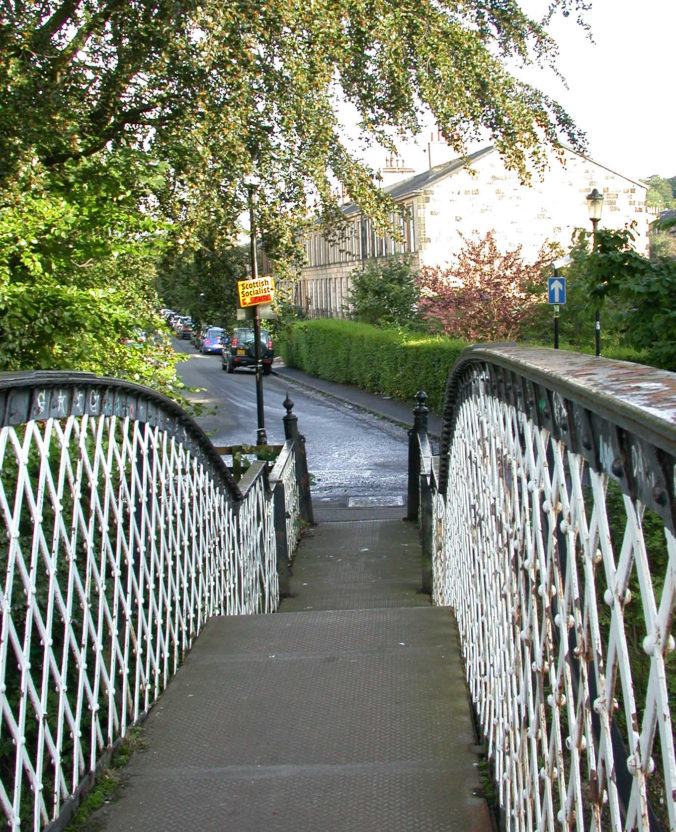







November 23, 2017 at 5:52 pm
As born and bred and lived in Nithsdale Street for 18 years (1948-1967) before parents moved out to the outskirts, I used to be taken to my aunt’s in East Kilbride by train from Strathbungo Station. On the left embankment facing away from Glasgow (Moray Place side) was an iron horse’s head & neck of which I would ‘amount’ and dream of being the Lone Ranger while waiting for my train to come. I have been trying without any success to learn of the history, if any, behind the horse’s head, what became of it after closure of the station. Seeing here that the footbridge was build by Abbey Engineering Works, Paisley, would it be possible that it was they who manufactured & put the head there, I wonder? Anyone have any gen or info about this?
January 17, 2019 at 5:14 pm
Now at least three people have asked the fate of the iron horse, but it remains a mystery. It may still be there in the undergrowth. For anyone else puzzling over this, there’s more on the Strathbungo Station page. Use Search, or click the railway tag at the foot of the article.
January 17, 2019 at 6:52 pm
Thank you Andrew. I very much doubt if the head may be still lying in the undergrowth as I pass the very spot occasionally;y when taking a train from Barrhead and have always scanned to see if there is any evidence. The head protruded up and out from the ground about a yard. Next time I am in the area I shall go over to the fence of where the head stood to see if there would be anything at all to uncover the mystery!
January 2, 2021 at 8:33 pm
I looked at the current footbridge and recall the addition of the extension to Darnley Road. It was a straightforward job for the blacksmiths and I think some top rail and runners were reused but they had fun with the set lengths of material available from the stair flights removal. More new material may have been used than people think. Since the bridge is based on components, adding raising pieces (for Overhead Line Electrification) at column heads and even heading to a different aperture in Darnley Road wall to counter the increased height should not be impossible.
February 8, 2023 at 11:25 pm
Hanna Donald and Wilson. An extraordinary company, with world wide exports in “knock down” ships (for re-erection including Drydocks sailed out to Indonesia) gasworks, bridges and wrought and cast iron structures, exist in many countries, some in daily use today. At their height they employed some 370 – 500 at their Paisley works. Then my great grandfather died young, leaving his sons and his widow the business. The family rancour and sheer incompetence that followed saw the business wound down; after the Great War, major contract were neither secured nor sought and eventually the Paisley site was sold. The Company disappears from the register about 1934. The last remaining family asset built in 1866 was the house in Kames, sold in 2021. The brothers (including my grandfather) resorted to legal bickering such that the Lawyers on all sides agreed that whist the fees were good, that unbelievably trivial fights such as over the cutting of discarded rose blooms at the house was beyond the pail. Sadly the family certainly nursed it’s wrath to keep it warm, now at last finally at an end. – The good news is that the Company archive has been saved and are with the Ballast Trust for preservation. Ship models are with Glasgow’s Transport Museum.